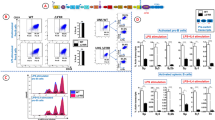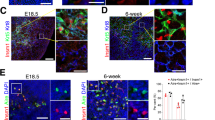Abstract
Class I histocompatibility antigens (H–2 antigens in the mouse) are 44,000-moIecular weight cell-surface glycoproteins, the proper insertion of which depends on their noncovalent association with β2-microglobulin (β2m) (reviewed in ref. 1). They are involved in a variety of immune phenomena, particularly in self/non-self recognition (reviewed in ref. 2). H–2 antigens and β2m are expressed by nearly all adult somatic cells. The status of their expression on pre-implantation mouse embryos remains controversial3,4 although they are generally agreed to be serologically detectable at post-implantation stages5. H–2 and β2m genes are therefore developmentally regulated. H–2 antigens have not been found on murine embryonal carcinoma (EC) cells6, which are widely used as an alternative to studying normal early embryonic cells7–9, but they become detectable during in vitro differentiation of EC cells10–12. During studies aimed at understanding the genetic mechanisms involved in the expression of H–2 antigens and β2m during differentiation, cDNAs reverse transcribed from mRNAs coding for H–2 or H–2-related heavy chains and β2m have been characterized13–16. H–2 and β2m cDNAs were used as probes to screen total poly(A)+ RNAs from various cell types. We report here that trace amounts of poly(A)+ RNA from EC cells were found to hybridize with these probes, finding which contrasts with results obtained on poly(A)+ RNA prepared from differentiated cells. These results, taken together with the absence of major rearrangements in H–2 and β2m genes during differentiation, suggest that H–2 and β2m expression is likely to be controlled at the level of transcription.
This is a preview of subscription content, access via your institution
Access options
Subscribe to this journal
Receive 51 print issues and online access
$199.00 per year
only $3.90 per issue
Buy this article
- Purchase on Springer Link
- Instant access to full article PDF
Prices may be subject to local taxes which are calculated during checkout
Similar content being viewed by others
References
Ploegh, H. L., Orr, H. T. & Strominger, J. L. Cell 24, 287–299 (1981).
Klein, J., Juretic, A., Baxevanis, C. N. & Nagy, Z. A. Nature 291, 455–460 (1981).
Webb, C. G., Gall, E. & Edelman, G. M. J. exp. Med. 146, 923–932 (1977).
Sawicki, J. A., Magnuson, T. & Epstein, C. J. Nature 294, 450–451 (1981).
Buc-Caron, M. H., Condamine, H. & Jacob, F. J. Embryol. exp. Morph. 47, 149–160 (1978).
Morello, D. Transplantation 26, 119–125 (1978).
Strickland, S. Cell 24, 277–278 (1981).
Evans, M. J. & Kaufman, M. H. Nature 292, 154–156 (1981).
Martin, G. R. Science 209, 768–776 (1980).
Nicolas, J. F., Dubois, P., Jakob, H., Gaillard, J. & Jacob, F. Annls Microbiol. Inst. Pasteur, Paris A126, 3–22 (1975).
Stern, P. L., Martin, G. R. & Evans, M. J. Cell 6, 455–465 (1975).
Gachelin, G. Biochim. biophys. Acta 516, 27–60 (1978).
Kvist, S. et al. Proc. natn. Acad. Sci. U.S.A. 78, 2772–2776 (1981).
Steinmetz, M. et al. Cell 24, 125–134 (1981).
Parnes, J. R. et al. Proc. natn. Acad. Sci. U.S.A. 78, 2213–2217 (1981).
Suggs, S. V., Wallace, R. B., Hirose, T., Kawashima, E. H. & Itakura, H. Proc. natn. Acad. Sci. U.S.A. 78, 6613–6617 (1981).
Nicolas, J. F. et al. Cancer Res. 36, 4229–4231 (1976).
Thomas, S. P. Proc. natn. Acad. Sci. U.S.A. 77, 5201–5205 (1980).
Dobberstein, B., Garoff, H., Warren, G. & Robinson, P. Cell 17, 759–769 (1979).
Brégégère, F. et al. Nature 292, 78–81 (1981).
Lalanne, J. L. et al. Nucleic Acids Res. (in the press).
Coligan, J. F., Kindt, T. J., Uehara, H., Martinko, J. & Nathenson, S. G. Nature 291, 35–39 (1981).
Jakob, H. et al. Expl Cell Res. 114, 403–408 (1978).
Cami, B., Brégégère, F., Abastado, J. P. & Kourilsky, P. Nature 291, 673–675 (1981).
Sege, K., Rask, L. & Peterson, P. R. Biochemistry 20, 4523–4529 (1981).
Steinmetz, M. et al. Cell 25, 683–692 (1981).
Michaelson, J. Immunogenetics 13, 167–171 (1981).
Croce, C. M. et al. Proc. natn. Acad. Sci. U.S.A. 78, 5754–5758 (1981).
Linnenbach, A., Huebner, K. & Croce, C. M. Proc. natn. Acad. Sci. U.S.A. 77, 4875–4879 (1980).
Haynes, S. R. & Jelinek, W. R. Proc. natn. Acad. Sci. U.S.A. 78, 6130–6134 (1981).
Auffray, C. & Rougeon, F. Eur. J. Biochem. 107, 303–314 (1980).
Maniatis, T., Jeffrey, A. & Kleid, D. Proc. natn. Acad. Sci. U.S.A. 72, 1184–1188 (1975).
Author information
Authors and Affiliations
Rights and permissions
About this article
Cite this article
Morello, D., Daniel, F., Baldacci, P. et al. Absence of significant H–2 and β2-microglobulin mRNA expression by mouse embryonal carcinoma cells. Nature 296, 260–262 (1982). https://doi.org/10.1038/296260a0
Received:
Accepted:
Issue Date:
DOI: https://doi.org/10.1038/296260a0
This article is cited by
-
Low expression of dendritic cell-specific intercellular adhesion molecule-3-grabbing nonintegrin in non-Hodgkin lymphoma and a significant correlation with β2-microglobulin
Medical Oncology (2014)
-
MHC class I surface expression in embryo-derived cell lines inducible with peptide or interferon
Nature (1991)
-
Developmental and tissue-specific expression of the Q5 k gene
Immunogenetics (1991)
-
TransfectedH-2K b gene as a cause of embryonal carcinoma cell rejection in vivo
Immunogenetics (1989)
-
Molecular analysis of expression of parental cell properties in hybrids between monocytes and a myeloma cell line
Somatic Cell and Molecular Genetics (1988)
Comments
By submitting a comment you agree to abide by our Terms and Community Guidelines. If you find something abusive or that does not comply with our terms or guidelines please flag it as inappropriate.



